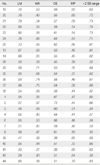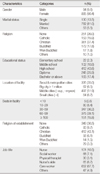Abstract
Purpose
The purpose of this study was to develop a tool to evaluate patient safety culture in nursing homes and to test its validity and reliability.
Methods
A preliminary tool was developed through interviews with focus group, content validity tests, and a pilot study. A nationwide survey was conducted from February to April, 2011, using self-report questionnaires. Participants were 982 employees in nursing homes. Data were analyzed using Cronbach's alpha, item analysis, factor analysis, and multitrait/multi-Item analysis.
Results
From the results of the analysis, 27 final items were selected from 49 items on the preliminary tool. Items with low correlation with total scale were excluded. The 4 factors sorted by factor analysis contributed 63.4% of the variance in the total scale. The factors were labeled as leadership, organizational system, working attitude, management practice. Cronbach's alpha for internal consistency was .95 and the range for the 4 factors was from .86 to .93.
Figures and Tables
Table 3
Multitrait/Multi-item Matrix (Correlation Matrix Corrected for Overlap) for Item Convergent and Item Discriminant

References
1. Accreditation Canada. Canadian health accreditation report. 2010. Retrieved January 31, 2010. from http://www.accreditation.ca/en/content.aspx?pageid=84&terms=2010+Canadian+health+Accreditation+report.
2. Agency for Healthcare Research and Quality. Nursing home surveys on patient safety culture. 2008. Retrieved May 9, 2012. from http://www.ahrq.gov/professionals/quality-patient-safety/patient-safety-culture/nursing-home/index.html.
3. Bonner AF, Castle NG, Perera S, Handler SM. Patient safety culture: A review of the nursing home literature and recommendations for practice. Ann Longterm Care. 2008; 16(3):18–22.
4. Castle NG. Nurse aides' ratings of the resident safety culture in nursing homes. Int J Qual Health Care. 2006; 18(5):370–376. http://dx.doi.org/10.1093/intqhc/mzl038.
5. Castle NG, Sonon KE. A culture of patient safety in nursing homes. Qual Saf Health Care. 2006; 15(6):405–408. http://dx.doi.org/10.1136/qshc.2006.018424.
6. Colla JB, Bracken AC, Kinney LM, Weeks WB. Measuring patient safety climate: a review of surveys. Qual Saf Health Care. 2005; 14(5):364–366. http://dx.doi.org/10.1136/qshc.2005.014217.
7. Committee on Quality of Health Care in America, & Institute of Medicine. Crossing the quality chasm: A new health system for the 21st century. Washington, DC: National Academy Press;2001.
8. Cooper JB. Developing a culture of safety. Biomed Instrum Technol. 2003; 37(3):212–214.
9. Feng X, Bobay K, Weiss M. Patient safety culture in nursing: Adimensional concept analysis. J Adv Nurs. 2008; 63(3):310–319. http://dx.doi.org/10.1111/j.1365-2648.2008.04728.x.
10. Flin R, Yule S. Leadership for safety: Industrial experience. Qual Saf Health Care. 2004; 13:Suppl 2. ii45–ii51. http://dx.doi.org/10.1136/qhc.13.suppl_2.ii45.
11. Handler SM, Castle NG, Studenski SA, Perera S, Fridsma DB, Nace DA, et al. Patient safety culture assessment in the nursing home. Qual Saf Health Care. 2006; 15(6):400–404. http://dx.doi.org/10.1136/qshc.2006.018408.
12. Havens DS, Aiken LH. Shaping systems to promote desired outcomes. The magnet hospital model. J Nurs Adm. 1999; 29(2):14–20.
13. Health and Safety Commission. Organizing for safety: Third report of the human factors study group of ACSNI. Sudbury, UK: HSE Books;1993.
14. Hughes CM, Lapane KL. Nurses' and nursing assistants' perceptions of patient safety culture in nursing homes. Int J Qual Health Care. 2006; 18(4):281–286. http://dx.doi.org/10.1093/intqhc/mzl020.
15. Jeong J, Seo YJ, Nam EW. Factors affecting patient safety management activities at nursing divisions of two university hospitals. Korean J Hosp Manage. 2006; 11(1):91–109.
16. Jeong KH. The status of caregiving for frail older persons and family caregiving burden. Health Welf Policy Forum. 2002; 66:17–31.
17. Kim JE, Kang MA, An KE, Sung YH. A survey of nurses' perception of patient safety related to hospital culture and reports of medical errors. Clin Nurs Res. 2007; 13(3):169–179.
18. Kim JS, Oh HY. Perceptions and attitude on use of physical restraints among caregivers in long term care facilities. J Korean Gerontol Soc. 2006; 26(2):347–360.
19. Kim M. The effectiveness of error reporting promoting strategy on nurse's attitude, patient safety culture, intention to report and reporting rate. J Korean Acad Nurs. 2010; 40(2):172–181. http://dx.doi.org/10.4040/jkan.2010.40.2.172.
20. Kim MC, Cho H, Sunwoo S, Kim SW, Cho HJ. Prevalence and associated factors of fall among the elderly in nursing home. J Korean Geriatr Soc. 1999; 3(4):29–38.
21. Krumberger JM. Building a culture of safety. RN. 2001; 64(1):32ac2–32ac3.
22. National Health Insurance. Long-term care facilities. 2013. Retrieved March 18, 2013. from http://www.longtermcare.or.kr/portal/site/nydev/MENUITEM_ORGSEARCH/.
23. Nieva VF, Sorra J. Safety culture assessment: A tool for improving patient safety in healthcare organizations. Qual Saf Health Care. 2003; 12:Suppl 2. ii17–ii23.
24. Sexton JB, Helmreich RL, Neilands TB, Rowan K, Vella K, Boyden J, et al. The safety attitudes questionnaire: Psychometric properties, benchmarking data, and emerging research. BMC Health Serv Res. 2006; 6:44. http://dx.doi.org/10.1186/1472-6963-6-44.
25. Tabachnick BG, Fidell LS. Using multivariate statistics. Needham Heights, MA: Allyn & Bacon, Inc;2006.
26. Ware JE Jr, Gandek B. Methods for testing data quality, scaling assumptions, and reliability: The IQOLA project approach. International quality of life assessment. J Clin Epidemiol. 1998; 51(11):945–952.
27. Ware JE, Snow KK, Kosinski M, Gandek B. SF-36 health survey: Manual and institute. Boston, MA: The Health Institute, New England Medical Center;1993.
28. Wisniewski AM, Erdley WS, Singh R, Servoss TJ, Naughton BJ, Singh G. Assessment of safety attitudes in a skilled nursing facility. Geriatr Nurs. 2007; 28(2):126–136. http://dx.doi.org/10.1016/j.gerinurse.2007.01.001.
29. Yoon SH, Wu X. Content analysis of patient safety culture in nursing homes. J Korean Acad Nurs Adm. 2013; 19(1):118–127. http://dx.doi.org/10.11111/jkana.2013.19.1.118.




 PDF
PDF ePub
ePub Citation
Citation Print
Print






 XML Download
XML Download